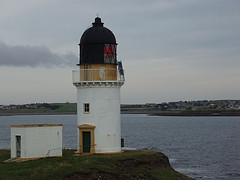The above map of southwestern Holland shows the areas in the provinces of Zuid Holland, Noord Brabant and Zeeland under water on the morning of 1 February 1953, in other words 56 years ago today. By time of posting, more than 1,800 people had drowned. A detailed account can be found here - please be aware that this site is originally in Dutch, but is being presented to you in English through Google Translator.
The disaster had started the day before, when a deep depression had moved southeast from Iceland towards northwestern Europe. On its western flank, hurricane force northwesterly winds battered Scotland - forcing the cargo ship Glen Macquarrie ashore near Borve on the Isle of Lewis, and smashing in the bowdoors of a ferry in the Irish Sea, sinking it with all hands - then eastern England. The high winds drove a springtide into the shallows of the southern North Sea, augmenting it as the narrows of the Strait of Dover did not allow sufficient drainage of the tidal surge. As a result, by 6pm on 31 January, the low tide saw the sea already dangerously close to the tops of the dykes in southwestern Holland. By midnight, high tide coincided with the height of the storm, causing the dykes to break.
The poor communications of the day, together with the fact that radio did not transmit at night, meant that the warnings came too late for many. The ringing of church bells was the only warning many got. Some got away in their attics, after the roofs floated away from the walls of the houses. The accounts are still available (in Dutch), but are a chilling reminder of the horror of that day.
The "Watersnoodramp", as the event is called in Holland, marked a turning point in thinking about coastal defences. After being on the backburner for more than 30 years, the dykes in the southwestern provinces suddenly became top priority. All the estuary mouths were closed off in the following 35 years, apart from the Westerschelde, which is the access route to Antwerp.
Fatalities did not just occur in Holland; 300 people died around the Wash and in the Thames Estuary in England.

1 comment:
Meanwhile pretty much the same was happening along the Norfolk and South coast of England ,many died and the government vowed it wouldnt happen again ,so put meaures into place for strethening sea walls and flood barriers ..love Jan xx
Post a Comment